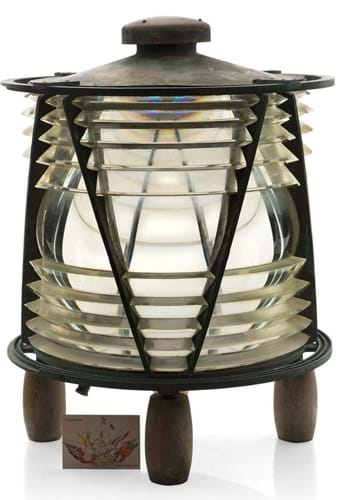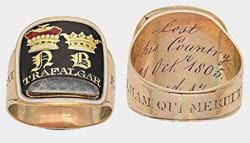Charles Miller (24% buyer’s premium) has a greater appreciation of the value of lighting than ever after his latest auction.
One of the stand-out, but unexpected, best-sellers was a 19th century Fresnel lamp housing. A bit of extra illumination came in handy just 10 lots from the end of the 381-lot Maritime and Scientific Models, Instruments & Art Auction on April 29 when the west London saleroom was plunged into darkness by a power cut.
“It had taken us near seven hours, a long sale, long enough you would think”, said Miller.
In an impressive example of improvisation and resourcefulness, torches were used and mobile phone networks and batteries employed – with help from thesaleroom.com – to finish the sale successfully (Miller added: “Actually, bidding was quicker when I wasn’t talking…”).
Great condition
The Fresnel lens was a first for Miller, having never offered one before. He said: “The idea of a Fresnel lens is to amplify light so it magnifies the strength of an oil lamp in there, which is why it works as a lighthouse lens.”
This example was perhaps on a harbour wall or river estuary and although on the small size for a lighthouse it was nonetheless on a decent scale. Heavily constructed in bronze, with internal A-frames supporting circular Fresnel lenses with two micrometers attached along the lower edge and loose chimney plate to top, now mounted to turned wooden feet, it measured 2ft 8in x 2ft 1½in (81.5 x 65cm).
Combined with the “especially good condition, no ‘nibbling’ or cracking”, said Miller, that size attracted bidders and the lot sold online for £16,000 to a UK private collector against an estimate of £800-1200.
It had been a reluctant sale by the Midlands vendor: “I think he had a marine industry background and he got it 40-50 years ago and had it in his garden.
He loved it but apparently there was an attempted theft, they decided it was too big to be inside the house so it was better to sell it.”
‘Exquisite’ engine
Another highlight came in the form of a 19th century exhibition-standard model for a twin cylinder compound engine which sold for £13,000 (guide £5000-8000) to a UK private collector.
The 16 x 16 x 12in (40.5 x 40.5 x 30.5cm) model featured a plate to the base inscribed RF Steele, London 1889.
This was described by Miller as a “real joy”. As an engine alone it was an “exquisite example of model engineering” but the way it now works was also “genius”. Normally it would be run through steam via a boiler attached, or you could use compressed air, but both those options can cause damage in the longer term.
However, someone had rigged up a very simple conversion with a two-stroke gramophone motor which gave about a 15-minute run. Miller added: “It had belonged to the late father of a lady who dropped it off but she hadn’t seen it working. I gave it a wind-up, bit of a shake and it sprang into life. It is a sheer quality object; I’m delighted it did well.”
Simple attractions
These biannual sales often feature intricate, attention-grabbing lots such as Napoleonic bone ships made by prisoners of war but it is sometimes the simplest lots that catch the eye.
Three Dutch East India Company silver ingots salvaged from The Rooswijk Cargo, c. 1739, performed well against hopes of £3000-5000 each.
The prices actually got stronger and the highest price, £6500 to the UK trade (for an ingot 6½in/16.5cm long; 1983gr), came for the last one offered.
Sailing from the Dutch island of Texel, carrying a cargo that included large quantities of silver coins and bullion intended for trade, the Rooswijk was heading for a nine-12 month journey to Batavia, then capital of the Dutch East Indies. The ship foundered towards the northeastern end of the Kellet Gut, after grounding on the Goodwin Sands in January 1740. The wreck was discovered in 2005.
Aircraft carrier relic
Estimated at £2000-3000 was a big, 14in x 3ft (35.5 x 91.5cm), rectangular lump of brass bearing the name Victorious, looking like a heavy-duty welcome mat. This is essentially what it was, in fact: when you climb up the companionway, the stairway by the side of a ship, the first thing your foot comes into contact with at the top is a treadplate like this.
And that name, Victorious, was significant to the price. The third carrier of the Illustrious class, Victorious was built by Vickers-Armstrong and launched just two weeks into the Second World War.
It took a further 18 months to complete the ship and even then she was pressed into service with only a quarter of her planes embarked. She unsuccessfully attacked Bismarck, Tirpitz twice and took part in the last-ditch attempt to relieve Malta – remembered chiefly for the incredible survival of the tanker Ohio.
Attached to the US fleet from May- August 1943, Victorious supported the USS Saratoga. Ordered to the Eastern Fleet she scored notable successes against Japanese installations in Indonesia and Palembang and supported the invasion of Okinawa with her two sisters Illustrious and Formidable.
Released from these duties three days before the war’s end, she repatriated prisoners-of-war for a year before serving as a training ship. She was being refitted at Portsmouth when a dockyard fire brought her career to a premature close and she was broken up at Faslane in 1969.
One of the bidders now trying to buy it was a former crew member who had taken this very treadplate and another one from Victorious. This example was given to a crewmate who had died and it had now come to auction. It had been set in concrete at a Cornwall house.
However, it sold to a different bidder for £5000, heading back to Cornwall.
Miller said: “The result was all about the history of the ship – and you don’t get many aircraft carrier treadplates.”
Lusitania model
While not ‘antique’, a builders’-style model of RMS Lusitania sold for £16,000 (four-times low estimate) had a poignant twist to its tale.
No original models of the Cunard liner torpedoed by a German U-boat in 1915 survive – they were simply converted to represent her almost identical sister ship Mauretania (ventilators being the main difference). One version, altered several times, survives on the QE 2 now moored permanently in Dubai.
This beautiful modern example was made by a Ukrainian modelmaker aged in his 20s, who, as a reserve officer, will be going to the front to fight in a war sadly raging 107 years after the Lusitania was sunk.















